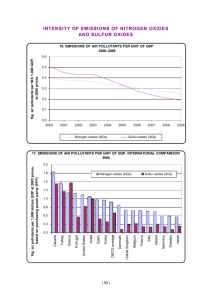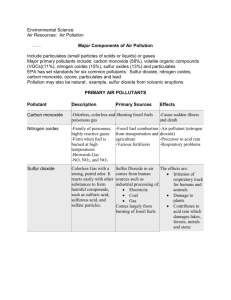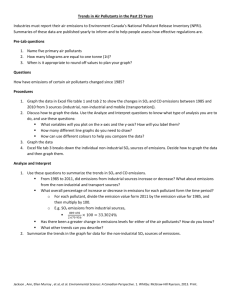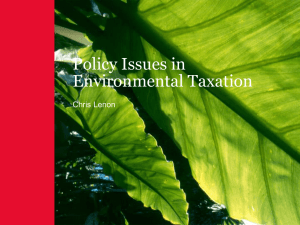Relevance of the indicator to sustainable development
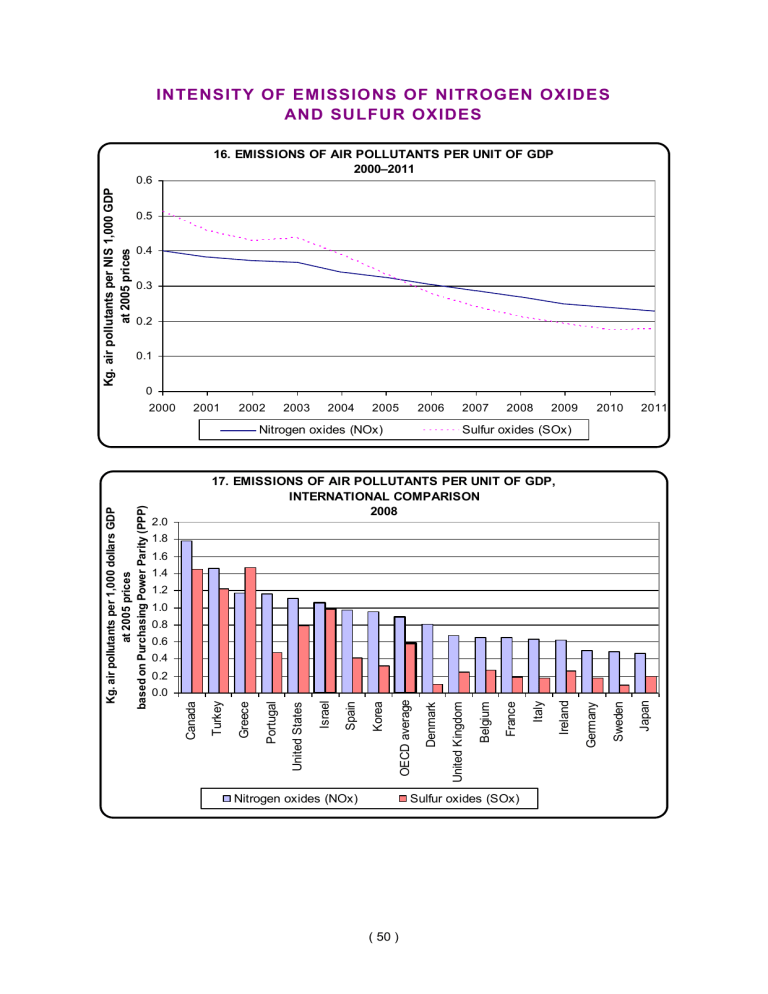
INTENSITY OF EMISSIO NS OF NITROGEN OXIDE S
AND SULFUR OXIDES
16. EMISSIONS OF AIR POLLUTANTS PER UNIT OF GDP
2000–2011
0.6
0.5
0.4
0.3
0.2
0.1
1.0
0.8
0.6
0.4
0.2
0.0
2.0
1.8
1.6
1.4
1.2
0
2000 2001 2002 2003 2004 2005 2006 2007 2008 2009 2010 2011
Nitrogen oxides (NOx) Sulfur oxides (SOx)
17. EMISSIONS OF AIR POLLUTANTS PER UNIT OF GDP,
INTERNATIONAL COMPARISON
2008
Nitrogen oxides (NOx) Sulfur oxides (SOx)
( 50 )
Description of the indicator
The indicator calculates the quantity of pollutant emissions in Israel per unit of production. It shows the ratio of the total sulfur oxide (SO x
) and nitrogen oxide (NO x
) emissions to the gross domestic product (GDP) in Israel in a given year. The ratio is calculated by dividing the emissions of pollutant by NIS 1,000 of GDP at constant prices.
Relevance of the indicator to sustainable development
The emission of pollutants into the air, as a result of energy consumption in transportation and industrial processes, is the main cause of air pollution. Air pollution causes harm to human health and ecosystems and, as a result, also to the economy and society. Poor air quality can have substantial repercussions for achievement of the objectives of sustainable development. The economic and social repercussions of air pollution include an increase in the cost of health services, the need for rehabilitation of structures, a decline in agricultural production, and general impairment of the quality of life. The main objective of sustainable development is decoupling emission of the pollutants from economic development and growth as reflected in the GDP. Thus, the lower the value of the indicator, the stronger the trend of decoupling. The objectives are achieved through emission standards and their supervision, technological improvements, energy efficiency, and a sustainable transportation policy.
Selected findings
In 2011, the ratio of nitrogen oxide emissions to the GDP was 0.23 kg. per NIS 1,000, compared to 0.4 kg. per NIS 1,000 in 2000.
The ratio of emissions of sulfur oxides and gross domestic product (GDP) in 2009 was 0.18 kg. per NIS 1,000, compared to 0.51 kg. per NIS 1,000 in 2000.
The data indicate that the absolute decline in the quantity of emissions of air pollutants was accompanied by decoupling between the increase in GDP (an increase of 38% since 2000) and air pollutant emissions.
Despite the decreases in emissions and the trend of decoupling between the emissions and economic growth, pollutant emission intensity in Israel (1.06 kg. NO x per 1,000 dollars GDP and 0.98 kg. SO x per 1,000 dollars GDP) is relatively high in comparison to most OECD countries, and higher than the average in OECD countries.
( 51 )
